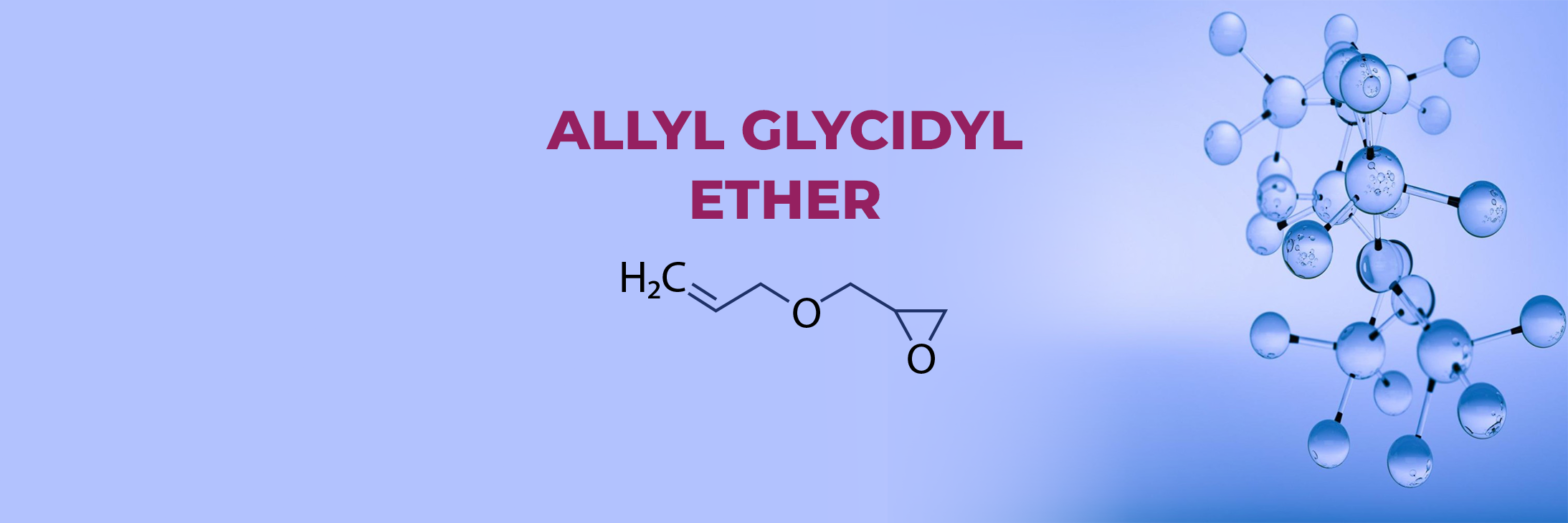INTRODUCTION
Allyl Glycidyl Ether (AGE) is a multifunctional organic intermediate made from epichlorohydrin and allyl chloride and is featured by high functionality and low chlorine content. Since it has an epoxy group and an allyl group, AGE reacts with a wide range of compounds.
MANUFACTURE
The synthesis process includes the ring opening reaction of materials allyl alcohol and epoxy chloropropane under the action of solid acid catalyst to prepare the intermediate allyl chlorohydrin; and the subsequent ring closing reaction with sodium hydroxide to prepare allyl glycidyl ether.
| Synonym | 2-(prop-2-enoxymethyl) oxirane, Allyl 2,3-epoxypropyl ether |
| CAS no. | 106-92-3 |
| EINECS No | 203-442-4 |
| Molecular formula | C6H10O2 |
| Molecular weight | 114.14 g/mol |
| Structure |  |
APPLICATIONS
| This product has a wide variety of applications: |
|---|
| Pharmaceutical Intermediates – A variety of active pharmaceutical ingredients (APIs) are, or could be, derived from glycidyl ether intermediates including therapeutic agents known as β-blockers. |
| Modifier for elastomers, adhesives, fibers, etc. |
| Reactive diluent for epoxies; reactive intermediate for coatings. |
| Sizing / finishing agent for fiberglass |
| Silane intermediate in electronic coatings |
| Defoamer Comonomer for polyepichlorohydrin rubber, unsaturated polyester resins, and crosslinked PU elastomers |
| Curing system additive in bisphenol A-epichlorohydrin epoxies for food-contact articles |
| Scavenger / Stabilizer in chlorinated solvents –used as acid scavengers in chlorinated solvents thereby improving stability. |
| Used in the synthesis of polymeric electrolytes for the fabrication of lithium batteries |
SPECIFICATIONS
| Test | Unit | Specifications |
|---|---|---|
| Appearance @ 25°C | – | Clear and colorless |
| Color | APHA | ≤ 10 |
| Total Chlorine | ppm | ≤ 10 |
| Water content | % | ≤ 0.05 |
| Purity | % | Min 99.5 |
PACKING
190 Kgs UN approved drums
STORAGE
Keep container tightly closed in a dry and well-ventilated place. Keep away from heat and sources of ignition.
REACH Status
AGE offered by ExSyn is registered under EU REACH regulations.
No matter the quantity you need, our exceptional quality and service will make ExSyn your supplier of choice! If you need any additional information or SDS, please contact us.
Iodine is anon-metallic, dark-grey/purple-black, lustrous, solid element. It is the heaviest and the rarest of stable halogens that can be found on the crust of earth.About fifty percent of all iodine produced and manufactured worldwide is used to form Organoiodine compounds. Iodine is an important element for many health-sustaining processes and essential for human thyroid health.
The product, acronymed Oct-NBE, is an organic compound with a cyclic ring system and a 8-membered hydrophobic chain. The structure renders the chemical special properties leading to its applications in diverse fields.
Nicotine is a hygroscopic, colorless to slight yellow, oily liquid, that is readily soluble in alcohol, ether or light petroleum. It is widely used recreationally as a stimulant and anxiolytic.
The product, acronymed ETD, is an organic compound with a fused bicyclic ring system and an ethylidene group. The structure renders the chemical special properties leading to its applications in diverse fields.
Sodium perchlorate monohydrate is the inorganic compound with the chemical formula NaClO4•H2O. It is the common existence form of sodium perchlorate, which can gradually absorb water in the air to form the monohydrate. Sodium perchlorate monohydrate is white rhombic crystal which is highly soluble in water and in alcohol. Its capacity to undergo redox reactions, liberating oxygen atoms, has been harnessed in the preparation of specialty chemicals, including pharmaceutical intermediates and fine chemicals.
Triphenylphosphine is a common organophosphorus compound that is frequently abbreviated as PPh3 or Ph3P. It is widely used in organic and organometallic compound synthesis because it is an effective reducing agent as well as a neutral ligand. At room temperature, PPh3 crystals are relatively air-stable and colourless.
Potassium chlorate holds significant importance across various industries due to its diverse applications. This white crystalline compound has been utilized for centuries as an essential ingredient in the production of matches, fireworks, and explosives, owing to its ability to release oxygen upon decomposition.
Podophyllotoxin is a non-alkaloid toxin lignan extracted from the roots and rhizomes of Podophyllum species. It is an organic heterotetracyclic compound that has a Furonaphthodioxole skeleton bearing a 3,4,5-trimethoxyphenyl substituent.
Octadecylphosphonic acid (ODPA), a versatile chemical compound, serves as a surfactant and dispersant in applications spanning coatings, lubricants, and corrosion inhibition. With its hydrophobic octadecyl chain linked to a phosphonic acid group, it excels in surface modification, boosting adhesion in metal surfaces.
